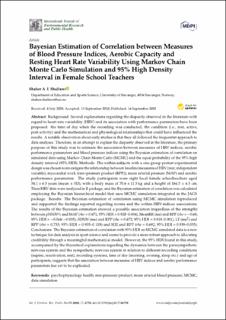| dc.contributor.author | Shalfawi, Shaher A. I. | |
| dc.date.accessioned | 2021-03-23T14:07:08Z | |
| dc.date.available | 2021-03-23T14:07:08Z | |
| dc.date.created | 2020-09-17T15:38:10Z | |
| dc.date.issued | 2020-09 | |
| dc.identifier.citation | Shalfawi, S.A.I. (2020) Bayesian Estimation of Correlation between Measures of Blood Pressure Indices, Aerobic Capacity and Resting Heart Rate Variability Using Markov Chain Monte Carlo Simulation and 95% High Density Interval in Female School Teachers. International Journal of Environmental Research and Public Health, 17(18), | en_US |
| dc.identifier.issn | 1660-4601 | |
| dc.identifier.uri | https://hdl.handle.net/11250/2735148 | |
| dc.description.abstract | Background: Several explanations regarding the disparity observed in the literature with regard to heart rate variability (HRV) and its association with performance parameters have been proposed: the time of day when the recording was conducted, the condition (i.e., rest, active, post activity) and the mathematical and physiological relationships that could have influenced the results. A notable observation about early studies is that they all followed the frequentist approach to data analyses. Therefore, in an attempt to explain the disparity observed in the literature, the primary purpose of this study was to estimate the association between measures of HRV indices, aerobic performance parameters and blood pressure indices using the Bayesian estimation of correlation on simulated data using Markov Chain Monte Carlo (MCMC) and the equal probability of the 95% high density interval (95% HDI). Methods: The within-subjects with a one-group pretest experimental design was chosen to investigate the relationship between baseline measures of HRV (rest; independent variable), myocardial work (rate–pressure product (RPP)), mean arterial pressure (MAP) and aerobic performance parameters. The study participants were eight local female schoolteachers aged 54.1 ± 6.5 years (mean ± SD), with a body mass of 70.6 ± 11.5 kg and a height of 164.5 ± 6.5 cm. Their HRV data were analyzed in R package, and the Bayesian estimation of correlation was calculated employing the Bayesian hierarchical model that uses MCMC simulation integrated in the JAGS package. Results: The Bayesian estimation of correlation using MCMC simulation reproduced and supported the findings reported regarding norms and the within-HRV-indices associations. The results of the Bayesian estimation showed a possible association (regardless of the strength) between pNN50% and MAP (rho = 0.671; 95% HDI = 0.928–0.004), MeanRR (ms) and RPP (rho = −0.68; 95% HDI = −0.064–−0.935), SDNN (ms) and RPP (rho = 0.672; 95% HDI = 0.918–0.001), LF (ms2) and RPP (rho = 0.733; 95% HDI = 0.935–0.118) and SD2 and RPP (rho = 0.692; 95% HDI = 0.939–0.055). Conclusions: The Bayesian estimation of correlation with 95% HDI on MCMC simulated data is a new technique for data analysis in sport science and seems to provide a more robust approach to allocating credibility through a meaningful mathematical model. However, the 95% HDI found in this study, accompanied by the theoretical explanations regarding the dynamics between the parasympathetic nervous system and the sympathetic nervous system in relation to different recording conditions (supine, reactivation, rest), recording systems, time of day (morning, evening, sleep etc.) and age of participants, suggests that the association between measures of HRV indices and aerobic performance parameters has yet to be explicated. | en_US |
| dc.language.iso | eng | en_US |
| dc.publisher | MDPI | en_US |
| dc.rights | Navngivelse 4.0 Internasjonal | * |
| dc.rights.uri | http://creativecommons.org/licenses/by/4.0/deed.no | * |
| dc.subject | helsefag | en_US |
| dc.subject | mean arterial blood pressure | en_US |
| dc.subject | blodtrykk | en_US |
| dc.title | Bayesian Estimation of Correlation between Measures of Blood Pressure Indices, Aerobic Capacity and Resting Heart Rate Variability Using Markov Chain Monte Carlo Simulation and 95% High Density Interval in Female School Teachers | en_US |
| dc.type | Peer reviewed | en_US |
| dc.type | Journal article | en_US |
| dc.description.version | publishedVersion | en_US |
| dc.rights.holder | © 2020 by the author | en_US |
| dc.subject.nsi | VDP::Medisinske Fag: 700::Idrettsmedisinske fag: 850 | en_US |
| dc.source.volume | 17 | en_US |
| dc.source.journal | International Journal of Environmental Research and Public Health | en_US |
| dc.source.issue | 18 | en_US |
| dc.identifier.doi | 10.3390/ijerph17186750 | |
| dc.identifier.cristin | 1830937 | |
| dc.source.articlenumber | 6750 | en_US |
| cristin.ispublished | true | |
| cristin.fulltext | original | |
| cristin.qualitycode | 1 | |

